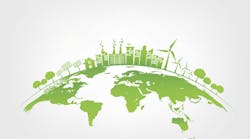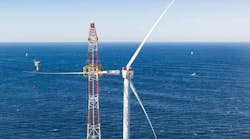On Nov. 28, 2018, the European Commission in Brussels adopted what it called “a strategic long-term vision for a prosperous, modern, competitive and climate neutral economy by 2050.” It calls the vision “A Clean Planet for all.”
According to its proponents and the authors of the vision statement, this new strategy shows how the EU member states can lead the way toward climate neutrality. The key methods for achieving these goals include: “investing into realistic technological solutions, empowering citizens, and aligning action in key areas such as industrial policy, finance, or research – while ensuring social fairness for a just transition.”
The Vice-President responsible for the Energy Union, Maroš Šefčovič made the case for it this way: "We cannot safely live on a planet with the climate that is out of control. But that does not mean that to reduce emissions, we should sacrifice the livelihoods of Europeans. Over the last years, we have shown how to reduce emissions, while creating prosperity, high-quality local jobs, and improving people’s quality of life. Europe will inevitably continue to transform. Our strategy now shows that by 2050, it is realistic to make Europe both climate neutral and prosperous, while leaving no European and no region behind.”
The EU’s Commissioner for Climate Action and Energy, Miguel Arias Cañete said that "the EU has already started the modernization and transformation toward a climate neutral economy. And today, we are stepping up our efforts as we propose a strategy for Europe to become the world's first major economy to go climate neutral by 2050. Going climate neutral is necessary, possible and in Europe's interest. It is necessary to meet the long-term temperature goals of the Paris Agreement. It is possible with current technologies and those close to deployment. And it is in Europe's interest to stop spending on fossil fuel imports and invest in meaningful improvements to the daily of all Europeans. No European, no region should be left behind. The EU will support those more impacted by this transition so that everyone's ready to adapt to the new requirements of a climate neutral economy.”
Meanwhile, the EU’s Commissioner for Transport, Violeta Bulc said that “all transport modes should contribute to the decarbonization of our mobility system. The goal is to reach net-zero emissions by 2050. This requires a system approach with low and zero emission vehicles, strong increase in rail network capacity, and a much more efficient organization of the transport system, based on digitalization; incentives for behavioral changes; alternative fuels and smart infrastructure; and global commitments. All this driven by innovation and investments."
Following on the invitation by the European Council – which was issued in March 2018 – the Commission's vision for a climate neutral future covers nearly all EU policies. Furthermore, it is in line with the Paris Agreement objectives: to keep temperature increase to well below 2°C, and to pursue efforts to keep it to 1.5°C. For the EU to lead the world towards climate neutrality means achieving it by 2050.
The purpose of this new EU long-term strategy is not to set targets, but to create a vision and sense of direction, plan for it, and inspire as well as enable stakeholders, researchers, entrepreneurs and citizens alike to develop new and innovative industries, businesses and associated jobs.
The EU's leaders say that they have a strong mandate from their citizens. According to the latest special Eurobarometer (published in November 2018) 93% of Europeans believe climate change to be caused by human activity and 85% agree that fighting climate change and using energy more efficiently can create economic growth and jobs in Europe. With the vision the EU presented, the Commissioners say that they can inform others how the EU can deliver collectively a clean planet. And the Eu can show that transforming the EU’s economy is possible and beneficial.
The long-term strategy delves deeply into the portfolio of options available for EU Member States, EU-based business and citizens, and how these can contribute to economic modernization while improving the European quality of life. The long-term strategy seeks to ensure that this transition is socially fair and enhances the competitiveness of EU economy and industry on global markets, securing high quality jobs and sustainable growth in Europe, while also helping address other environmental challenges, such as air quality or biodiversity loss.
From the EU’s point of view, the road to a climate neutral economy would require joint action in seven strategic areas: energy efficiency; deployment of renewables; clean, safe and connected mobility; competitive industry and circular economy; infrastructure and interconnections; bio-economy and natural carbon sinks; carbon capture and storage to address remaining emissions. Pursuing all these strategic priorities would contribute to making this new EU vision a reality.
Among the many next steps, which are described in the Commission’s report on the new strategy:
The European Commission invites the European Council, the European Parliament, the Committee of the Regions and the Economic and Social Committee to consider the EU vision for a climate neutral Europe by 2050. In order to prepare EU Heads of State and Government for shaping the Future of Europe at the European Council on May 9, 2019, in Sibiu, ministers “should hold extensive policy debates on the contribution of their respective policy areas to the overall vision.”
The long-term strategy is an invitation to all EU institutions, the national parliaments, business sector, non-governmental organizations, cities and communities, as well as citizens - and especially the youth, to participate in ensuring the EU can continue to show leadership and hold other international partners to do the same. This EU-wide informed debate “should allow the EU to adopt and submit an ambitious strategy by early 2020 to the UNFCCC as requested under the Paris Agreement”.
- EU Member States will submit to the European Commission, by the end of 2018, their draft National Climate and Energy Plans, which are central for the achievement of the 2030 climate and energy targets and which should be forward-looking and take into account in the EU long term strategy.
- In addition, an increasing number of EU regions, EU municipalities and EU business associations are drawing up their own vision for 2050. This will enrich the debate and contribute to defining Europe’s answer to the global challenge of climate change.
- Internationally, over the coming year the EU “should expand its cooperation closely with its international partners, so that all parties to the Paris Agreement develop and submit a long-term national mid-century strategy by 2020 in the light of the recent IPCC Special report on 1.5̊ Celsius.”


